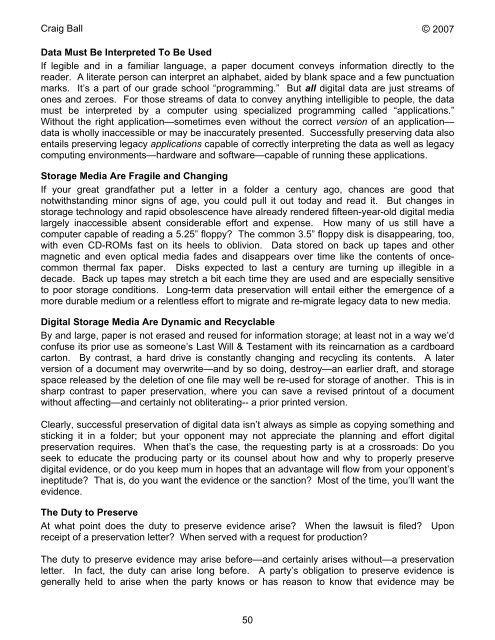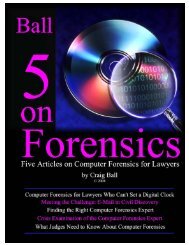Six Articles on Electronic - Craig Ball
Six Articles on Electronic - Craig Ball
Six Articles on Electronic - Craig Ball
You also want an ePaper? Increase the reach of your titles
YUMPU automatically turns print PDFs into web optimized ePapers that Google loves.
<strong>Craig</strong> <strong>Ball</strong> © 2007<br />
Data Must Be Interpreted To Be Used<br />
If legible and in a familiar language, a paper document c<strong>on</strong>veys informati<strong>on</strong> directly to the<br />
reader. A literate pers<strong>on</strong> can interpret an alphabet, aided by blank space and a few punctuati<strong>on</strong><br />
marks. It’s a part of our grade school “programming.” But all digital data are just streams of<br />
<strong>on</strong>es and zeroes. For those streams of data to c<strong>on</strong>vey anything intelligible to people, the data<br />
must be interpreted by a computer using specialized programming called “applicati<strong>on</strong>s.”<br />
Without the right applicati<strong>on</strong>—sometimes even without the correct versi<strong>on</strong> of an applicati<strong>on</strong>—<br />
data is wholly inaccessible or may be inaccurately presented. Successfully preserving data also<br />
entails preserving legacy applicati<strong>on</strong>s capable of correctly interpreting the data as well as legacy<br />
computing envir<strong>on</strong>ments—hardware and software—capable of running these applicati<strong>on</strong>s.<br />
Storage Media Are Fragile and Changing<br />
If your great grandfather put a letter in a folder a century ago, chances are good that<br />
notwithstanding minor signs of age, you could pull it out today and read it. But changes in<br />
storage technology and rapid obsolescence have already rendered fifteen-year-old digital media<br />
largely inaccessible absent c<strong>on</strong>siderable effort and expense. How many of us still have a<br />
computer capable of reading a 5.25” floppy? The comm<strong>on</strong> 3.5” floppy disk is disappearing, too,<br />
with even CD-ROMs fast <strong>on</strong> its heels to oblivi<strong>on</strong>. Data stored <strong>on</strong> back up tapes and other<br />
magnetic and even optical media fades and disappears over time like the c<strong>on</strong>tents of <strong>on</strong>cecomm<strong>on</strong><br />
thermal fax paper. Disks expected to last a century are turning up illegible in a<br />
decade. Back up tapes may stretch a bit each time they are used and are especially sensitive<br />
to poor storage c<strong>on</strong>diti<strong>on</strong>s. L<strong>on</strong>g-term data preservati<strong>on</strong> will entail either the emergence of a<br />
more durable medium or a relentless effort to migrate and re-migrate legacy data to new media.<br />
Digital Storage Media Are Dynamic and Recyclable<br />
By and large, paper is not erased and reused for informati<strong>on</strong> storage; at least not in a way we’d<br />
c<strong>on</strong>fuse its prior use as some<strong>on</strong>e’s Last Will & Testament with its reincarnati<strong>on</strong> as a cardboard<br />
cart<strong>on</strong>. By c<strong>on</strong>trast, a hard drive is c<strong>on</strong>stantly changing and recycling its c<strong>on</strong>tents. A later<br />
versi<strong>on</strong> of a document may overwrite—and by so doing, destroy—an earlier draft, and storage<br />
space released by the deleti<strong>on</strong> of <strong>on</strong>e file may well be re-used for storage of another. This is in<br />
sharp c<strong>on</strong>trast to paper preservati<strong>on</strong>, where you can save a revised printout of a document<br />
without affecting—and certainly not obliterating-- a prior printed versi<strong>on</strong>.<br />
Clearly, successful preservati<strong>on</strong> of digital data isn’t always as simple as copying something and<br />
sticking it in a folder; but your opp<strong>on</strong>ent may not appreciate the planning and effort digital<br />
preservati<strong>on</strong> requires. When that’s the case, the requesting party is at a crossroads: Do you<br />
seek to educate the producing party or its counsel about how and why to properly preserve<br />
digital evidence, or do you keep mum in hopes that an advantage will flow from your opp<strong>on</strong>ent’s<br />
ineptitude? That is, do you want the evidence or the sancti<strong>on</strong>? Most of the time, you’ll want the<br />
evidence.<br />
The Duty to Preserve<br />
At what point does the duty to preserve evidence arise? When the lawsuit is filed? Up<strong>on</strong><br />
receipt of a preservati<strong>on</strong> letter? When served with a request for producti<strong>on</strong>?<br />
The duty to preserve evidence may arise before—and certainly arises without—a preservati<strong>on</strong><br />
letter. In fact, the duty can arise l<strong>on</strong>g before. A party’s obligati<strong>on</strong> to preserve evidence is<br />
generally held to arise when the party knows or has reas<strong>on</strong> to know that evidence may be<br />
50













